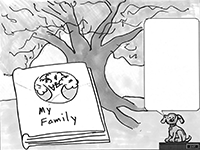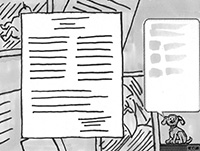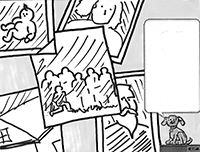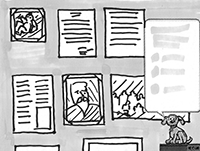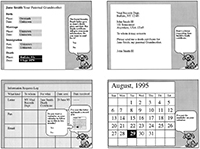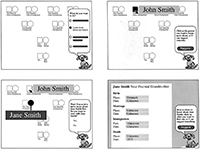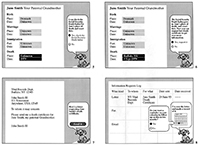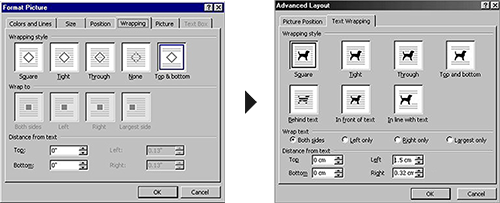- Microsoft Product Design
Microsoft hired me as the Design Lead for the Lifeworks Group in the Consumer Products Division in May, 1995. The Consumer Products Division made interactive CD-ROMs, which were the next big thing just before the internet came along. A couple weeks after I was hired, Bill Gates wrote his famous memo, The Internet Tidal Wave, and about nine months after that the Consumer Products Division was eliminated. I landed in the Office Design and Usability Group as a Product Designer, where I collaborated with Usability Engineers and Program Managers on Publisher, Project, Word, and future projects, until I resigned in May, 2002.
- Lifeworks
The Lifeworks Group comprised four Program Managers, three Developers, a Product Planner, and myself. Our group had two initial products lined up for the Microsoft Bob platform: a genealogy app, and an interactive version of the perennially reprinted job-hunting book, What Color is Your Parachute? My first task was to envision the genealogy application. I still have some of the exploratory sketches:
We had barely started on the genealogy app when Microsoft eliminated the Bob platform. We were happy as a team to be freed of its constraints and pivoted to working on a more sophisticated solution. The main output of genealogy apps at the time was the family-tree diagram, but they had to be printed as hardcopy tiles, assembled, and taped together. I proposed that we build a platform for interactive, onscreen diagrams for viewing and navigating family trees. I worked on space-efficient displays, and began to write a spec.
Soon after we had started again our time ran out and the entire division was eliminated.
- Office
The Office Design and Usability Group comprised fifteen to twenty Usability Engineers, Product Designers, and Graphic Designers, dedicated to the Microsoft Office suite of productivity tools. Product Designers and Usability Engineers were paired, and assigned to work closely with the Program Managers of one of the suite's applications, usually for one or more product cycles which typically lasted two or more years. The bulk of our work consisted of designing and building interactive prototypes of new features for usability tests, observing tests, and iterating, in a waterfall development process. We built most of the usability protoypes with Macromedia Director and/or Office's Visual Basic.
The Office Group itself had twenty or more Program Managers, and some of the Office applications also had twenty or more Program Managers. Office was a mature product, and it represented roughly half of Microsoft's revenues alongside Windows. With its huge installed user base there was precious little room for innnovation. Unfortunately, due to NDA, I saved very little of my work. This Word dialog box redesign is one example, but does not fully represent the depth and range of the projects we worked on.
- Outcome
I was hesitant to take the job because of Microsoft Bob, but I liked that it was a small product team, and it was a lucrative offer. I was relieved when the Bob platform was eliminated, but my career was radically changed when The Lifeworks Group was, too. The transition from design lead for a small team to being one of many designers for a huge team was difficult. There was certainly a sense of exhilaration in working on a product used by so many, but it was also restrictive due to the inflexibility and glacially slow pace of change.
The experience obviously affected my enthusiasm and trajectory as a designer, and it took me a long time to understand what happened to me. Now I've regained my enthusiasm for design, and I have goals I haven't reached. Both design and I have learned from our experience, and I want to iterate.
